 Hyundai Accent: Gauges
Hyundai Accent: Gauges
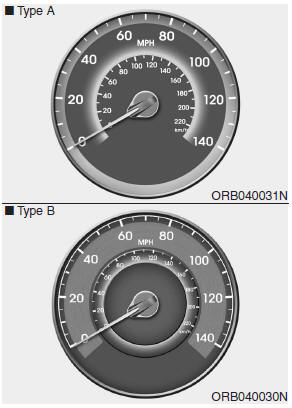
Speedometer
The speedometer indicates the speed of the vehicle.
The speedometer is calibrated in miles per hour and/or kilometers per hour.
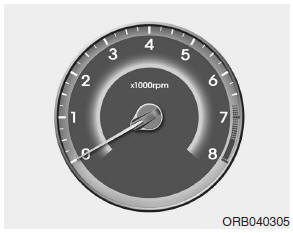
Tachometer
The tachometer indicates the approximate number of engine revolutions per minute (rpm).
Use the tachometer to select the correct shift points and to prevent lugging and/or over-revving the engine.
When the door is open, or if the engine is not started within 1 minute, the tachometer pointer may move slightly in ON position with the engine OFF. This movement is normal and will not affect the accuracy of the tachometer once the engine is running.
![]() CAUTION
CAUTION
Do not operate the engine within the tachometer's RED ZONE. This may cause severe engine damage.
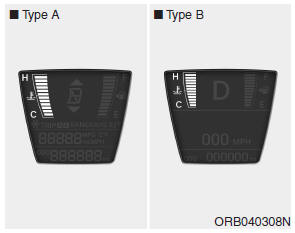
Engine temperature gauge
This gauge shows the temperature of the engine coolant when the ignition switch is ON.
Do not continue driving with an overheated engine. If your vehicle overheats, refer to ŌĆ£If the engine overheatsŌĆØ in section 6.
![]() CAUTION
CAUTION
If the gauge moves beyond the normal range area toward the ŌĆ£HŌĆØ position, it indicates overheating that may damage the engine.
![]() WARNING
WARNING
Never remove the radiator cap when the engine is hot. The engine coolant is under pressure and could cause severe burns. Wait until the engine is cool before adding coolant to the reservoir.
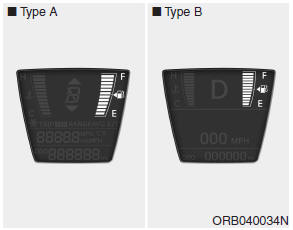
Fuel gauge
The fuel gauge indicates the approximate amount of fuel remaining in the fuel tank. The fuel tank capacity is given in section 8. The fuel gauge is supplemented by a low fuel warning light, which will illuminate when the fuel tank is near empty.
On inclines or curves, the fuel gauge may fluctuate or the low fuel warning light may come on earlier than usual due to the movement of fuel in the tank.
![]() WARNING - Fuel gauge
WARNING - Fuel gauge
Running out of fuel can expose vehicle occupants to danger. You must stop and obtain additional fuel as soon as possible after the warning light comes on or when the gauge indicator comes close to the E level.
![]() CAUTION
CAUTION
Avoid driving with a extremely low fuel level. Running out of fuel could cause the engine to misfire, damaging the catalytic converter.
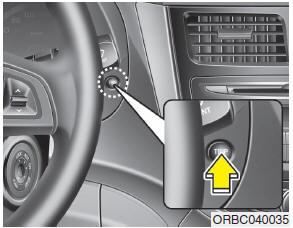
Trip computer
The trip computer is a microcomputer controlling the driver information system. It displays information related to driving on the LCD screen when the ignition switch is in the ON position. If the battery is disconnected, then all stored driving information (except odometer) is reset.
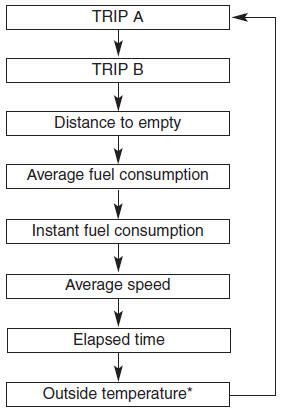
* : if equipped
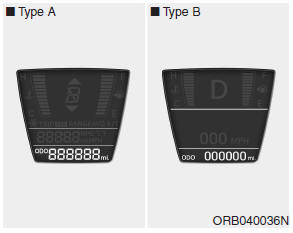
Odometer (mi. or km)
The odometer indicates the total distance the vehicle has been driven. You will also find the odometer useful to determine when periodic maintenance should be performed.
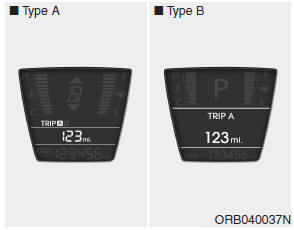
Tripmeter (mi. or km)
TRIP A : Tripmeter A
TRIP B : Tripmeter B
This mode indicates the distance of individual trips selected since the last tripmeter reset.
The meter's working range is from 0.0 to 9999.9 miles (0.0 to 9999.9 km).
Pressing the RESET button for more than 1 second, when the tripmeter (TRIP A or TRIP B) is being displayed, clears the tripmeter to zero (0.0).
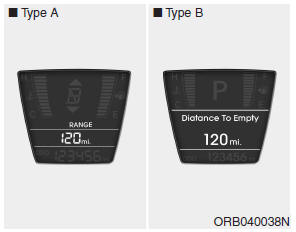
Distance to empty (mi. or km)
This mode indicates the estimated distance to empty based on the current fuel in the fuel tank and the amount of fuel delivered to the engine. When the remaining distance is below 30 miles (50 km), ŌĆ£---ŌĆØ will be displayed and the distance to empty indicator will blink. The meterŌĆÖs working range is from 30 to 999 miles (50 to 999 km).
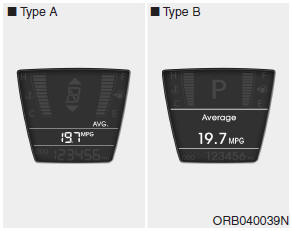
Average fuel consumption (if equipped) (MPG or l/100 km)
This mode calculates the average fuel consumption from the total fuel used and the distance since the last average economy reset. The total fuel used is calculated from the fuel consumption input. For an accurate calculation, drive more than 0.03 miles (50 m).
Pressing the RESET button for more than 1 second, when the average fuel economy is being displayed, clears the average fuel consumption to zero (----).
If the vehicle speed exceeds 1.6 MPH (1km/h) after being refueling, the average fuel economy will be cleared to zero (----).
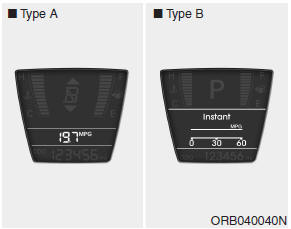
Instant fuel consumption (l/100 km or MPG)
This mode calculates the instant fuel consumption every 2 seconds from the driving distance and quantity of fuel injection.
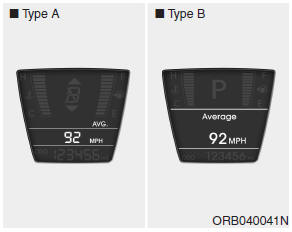
Average speed (MPH or km/h)
This mode calculates the average speed of the vehicle since the last average speed reset.
Even if the vehicle is not in motion, the average speed keeps changing while the engine is running.
Pressing the RESET button for more than 1 second, when the average speed is being displayed, clears the average speed to zero (---).
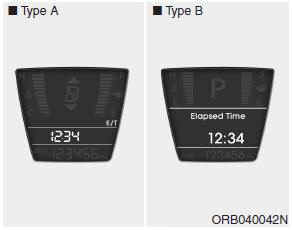
Elapsed time
This mode indicates the total time traveled since the last driving time reset. Even if the vehicle is not in motion, the driving time keeps increasing while the engine is running.
The meterŌĆÖs working range is from 00:00~99:59.
Pressing the RESET button for more than 1 second, when the driving time is being displayed, clears the driving time to zero (00:00).
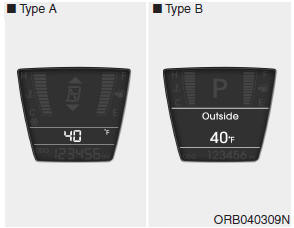
Outside thermometer (if equipped)
The current outside temperature is displayed in 1┬░C (1┬░F) increments. The temperature range is between -40┬░C ~ 60┬░C (-40┬░F ~ 140┬░F).
The outside temperature on the display may not change immediately like a general thermometer to prevent the driver from being inattentive.
 Instrument panel illumination
Instrument panel illumination
When the vehicleŌĆÖs parking lights or headlights are on, press the upper or lower
part of the switch to adjust the brightness of the instrument panel illumination. ...
 Warnings and indicators
Warnings and indicators
All warning lights are checked by turning the ignition switch ON (do not start
the engine). Any light that does not illuminate should be checked by an authorized
HYUNDAI dealer.
After starting th ...
See also:
Emergency Towing
There are three popular methods of towing a vehicle :
-
The operator loads the vehicle on the back of truck.
This is best way of transporting the vehicle.
...
Filter inspection
The climate control air filter should be replaced according to the Maintenance
Schedule. If the vehicle is operated in severely air-polluted cities or on dusty
rough roads for a long period, it sh ...
Low tire pressure telltale
When the tire pressure monitoring system warning indicator is illuminated, one
or more of your tires is significantly under-inflated.
If the telltale illuminates, immediately reduce your speed, a ...
